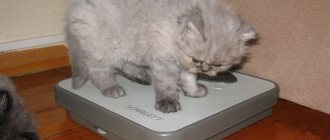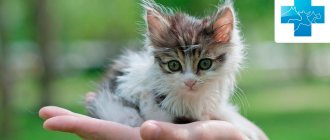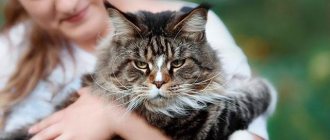Home » Useful Information
Weight gain during the period of active growth of a kitten plays a big role. Monitoring this indicator is important so that deviations can be noticed in time and the causes that caused them can be eliminated. To make it easier to keep weight characteristics under control, you can use special tables.
- 2 Why do you need to monitor a kitten’s weight at different periods of its growth?
2.1 What is a weight diary
- 3.1 Video: how to weigh a cat
- 4.1 Table: average body weight of kittens in the first 6 months of life
What can a kitten weigh at birth?
The weight of a kitten at birth can depend on various characteristics:
- Gender. At the moment of birth, a cat may not differ in weight from a female cat, but this difference becomes noticeable after some time. Males are usually a little larger than female cats, and therefore weigh a little more.
- Number of kittens born. It has long been noted that the more numerous the litter, the greater the underweight of each individual.
- The completeness of the diet of a mother cat during pregnancy.
- Belonging to a certain breed. For example, a Maine Coon kitten at the time of birth will weigh more than a baby, for example, of the Siamese breed.
Newborn kittens of large breeds (for example, Maine Coons) will weigh more than their graceful relatives
A newborn kitten most often weighs no more than one hundred and twenty grams. He is still blind and mostly immobilized. All he can do is eat, grow and get enough sleep. Staying in this mode, the baby can gain up to 15 grams per day.
Weight control and diet for cats: what do we have?
The well-being of any cat, both short and long term, depends on maintaining a healthy weight. This not only affects the overall quality of life, but also helps reduce the risk of disease and increase life expectancy.
Unfortunately, recent studies have shown that about 50% of pets are overweight or obese. Such high rates are largely due to the fact that pets may experience a lack of physical activity. In addition, owners do not always take into account the special dietary requirements at different stages of a cat's life to maintain its normal weight. Just like humans, your furry friend's nutritional needs vary depending on lifestyle
In this situation, it is important to maintain a balance.
The following factors may also contribute to excess weight gain in cats:
- floor;
- sterilization;
- accompanying illnesses;
- age;
- lack of physical activity.
It is now known that selecting an animal’s diet requires an individual approach that takes into account the lifestyle and age of a particular pet.
Why do you need to monitor a kitten’s weight at different periods of its growth?
A kitten's weight is a very important aspect of its development. The baby's weight needs to be monitored for several reasons. For example, by the age of one month, a kitten can weigh up to 500 grams. If his weight differs from this indicator in the direction of decrease, this may be caused by the following reasons:
- diseases, congenital or acquired;
- numerous litters;
- the mother’s lack of a complete diet that can provide nutrition for both the cat herself and her babies.
During the feeding period, the cat's food volume should be increased by 30% of the normal daily intake.
An underweight kitten may indicate that the baby is malnourished. He becomes lethargic, sleeps a lot, and apart from the general mass of kittens. In this case, you need to increase the amount of food for the nursing cat and monitor how long the weak baby stays at her breast.
Once I brought foundlings to my nursing cat. They were left without a mother, and besides, unkind people simply abandoned them to their fate. The two babies quickly got used to it, actively sucked the cat and did not differ from her “native” kittens. One kitten was very weak, he could not defend his place at the nipple and was often left out of work. Sometimes he still managed to get comfortable, but he quickly got tired and soon fell asleep without having eaten enough. Since I closely followed the adaptation of foundlings, I immediately noticed this (literally within 24 hours). The baby had to be fed separately. I gave him a special mixture, but also tried to get him to latch on to the cat’s breast more often (the more lively brothers had to be pushed aside for a while). As a result, this baby still lagged behind the others in weight, but caught up with them in height by about a year.
If a kitten is diagnosed with any disease, then to correctly calculate the medicinal suspension you will also need to know the exact weight of the animal. Therefore, a conscientious owner always monitors this indicator.
What is a weight diary
Every caring owner should keep a kitten's weight diary. This must be done regardless of whether the kitten grows up alone or with its mother cat and brothers. It is necessary to record all weight indicators in the diary, which can later help track whether the baby is developing normally.
The weight diary can be kept in any form, as convenient for the owner. This is an ordinary notebook for me. In it I write down the date of birth of the kittens, the names I gave them, as well as everything related to caring for them. This is not only their weight, but also the dates of treatment for fleas and worms, as well as the dosage of drugs (which, by the way, depends on weight). This is very convenient because over time I forget when, for example, I processed animals. A hint notebook helps me remember, especially since I now have 4 cats and a dog, so it’s quite possible to forget or confuse something.
Development from 9 months to a year of life
During this period, the kitten is fully formed, its development is almost complete, and it continues to turn into an adult pet, increasing in size and gaining weight.
At 10 months of age, you can start switching your baby to adult food. However, this must be done gradually, mixing it with baby food.
Timely trimming of nails and dental care, as well as visits to the veterinarian will ensure the correct development for your baby and will allow you to adjust your upbringing and diet so that your pet grows healthy, active and receives all the necessary care.
How to weigh a kitten correctly
If the kitten is very small, then in order to weigh it, you can use a regular kitchen scale and a small box. To prevent the kitten from turning weighing into a game, the best time for the process is immediately after sleep. If the baby starts spinning and jumping, the indicators will be inaccurate. Trying to hold a playful baby with your hand can also get a distorted result.
To get the most accurate figure for the baby’s weight, you can follow two methods:
- First, weigh the box, then put the kitten in it and record the result again. Subtract the difference.
- Place the box on the scales, and only then turn them on. They will show zeros. After this, we put the baby in a box and get the figure for his body weight.
It is more convenient to weigh mobile kittens in small containers or boxes to get a more accurate result.
This way the owner will receive an exact figure in grams, which can be entered into the animal’s weight diary.
Video: how to weigh a cat
Obesity and problem solving
A cat is considered overweight if the waist cannot be felt, the ribs are covered with a layer of fat, and the stomach protrudes and has a spherical shape. Fatty deposits may also be visible on the limbs, lower back and muzzle. To help your animal, you should contact your veterinarian to prescribe corrective nutrition and recommendations for physical activity.
If the breeder decides to act independently, then it is important to follow the principle of gradualism. A sharp decrease in weight can lead to health problems, which the cat is already weakened by. The diet should be less calorie. It is best to choose a special medicinal food for animals suffering from obesity.
It is important to prevent overeating and control your pet’s diet. Therefore, it is, of course, possible to pamper an animal with treats, but it is important to be reasonable. Obesity not only brings discomfort to a cat's life when moving, but is also fraught with the development of diseases such as diabetes, heart pathologies, kidney failure and joint problems.
What are the norms for weight gain for kittens?
The first six months of a kitten's life are the most active in terms of growth. Accordingly, if the baby is healthy and develops normally, he will regularly gain weight:
- Before the baby turns 1 month old, he rapidly gains weight - about 15 g per day. At the same time, by the end of the 1st week, the kitten should double its birth weight. Weigh him daily during this period.
- From 1 to 2 months, weight gain occurs systematically, on average 100–150 g per week. Weigh the baby once every 3 days.
- After 2 months, weight gain varies from person to person. It depends on the breed and nutrition of the animal. He is weighed weekly for up to 6 months, then once a month for up to a year. It is important that there is weight gain. If it is absent, you should contact your veterinarian to find out the reasons.
Since there are no exact indicators of body weight gain (much depends on the individual characteristics of the animal, its living conditions and diet), the owner should focus on the average weight standards for kittens.
Table: average body weight of kittens in the first 6 months of life
| Age | Weight |
| 1–6 days | 70–130 g |
| 7 days | 85–200 g |
| 7–14 days | 225–400 g |
| 14–21 days | 285–500 g |
| 1 month | 500–750 g |
| 2 months | 1000–1500 g |
| 3 months | 1700–2300 g |
| 4 months | 2500–3600 g |
| 5 months | 3100–4200 g |
| 6 months | 3500–4800 g |
Short-term stabilization of weight in a kitten
The phenomenon of short-term weight stabilization often occurs. There is no need to panic if the kitten’s weight gain “frozen” for several days, and then continues in the same progression.
Such an anomaly can manifest itself at any time stage of the baby’s life. It often occurs when there is a transition from breastfeeding to regular food (dry food or natural food). This is due to the fact that the baby’s body goes through a period of adaptation to receiving new nutrients.
However, you should worry if there are no changes for more than a few days (for example, a week). This may mean that the kitten is malnourished or sick or infected with parasites. You should visit a veterinarian as soon as possible if, after weight stagnation, body weight begins to decrease rather than increase.
Table: kitten weights by month (values for popular breeds)
| Kitten age | Maine Coon cat weight (g) | Maine Coon cat weight (g) | British cat weight (g) | British cat weight (g) | Scottish cat weight (g) | Scottish cat weight (g) |
| Newborn kitten | 120–140 | 120–160 | 60–140 | 70–140 | 60–140 | 70–140 |
| 1 Week | 180–230 | 200–260 | 110–250 | 240–260 | 110–250 | 240–280 |
| 2 week | 280–340 | 400–360 | 150–360 | 340–400 | 140–360 | 340–400 |
| 3 week | 420–550 | 440–600 | 210–420 | 400–630 | 200–420 | 390–630 |
| 4 week | 560–680 | 630–750 | 250–600 | 550–740 | 240–600 | 540–740 |
| 2 months | 1100–1400 | 1200–1500 | 450–900 | 1000–1700 | 400–900 | 1000–1700 |
| 3 months | 1700–2300 | 1800–2300 | 1000–1500 | 1500–2500 | 1000–1500 | 1500–2500 |
| 4 months | 2700–3600 | 3000–3800 | 1700–2400 | 2100–3900 | 1700–2400 | 2100–3900 |
| 5 months | 2900–3900 | 3000–5500 | 2200–2900 | 2600–4300 | 2200–2900 | 2600–4300 |
| 6 months | 3200–4000 | 3900–6000 | 2300–3600 | 3000–5400 | 2300–3600 | 3000–5400 |
| 7 months | 3500–4100 | 4200–6500 | 2400–3900 | 3300–5600 | 2400–3900 | 3300–5600 |
| 8 months | 3800–4300 | 4500–6900 | 2500–4100 | 3500–6000 | 2500–4100 | 3500–6000 |
| 9 months | 4100–5000 | 5000–7000 | 2500–4300 | 3800–6400 | 2500–4300 | 3800–6400 |
| 10 months | 4200–5500 | 5200–7700 | 2500–4400 | 4100–6700 | 2500–4400 | 4100–6700 |
| 11 months | 4300–6000 | 5700–8000 | 2500–4500 | 4300–6800 | 2500–4500 | 4300–6800 |
| 12 months | 4500–6300 | 5700–9000 | 2500–4600 | 4500–7000 | 3500–4600 | 4500–7000 |
How to determine weight standards for a mongrel kitten
When it is not possible to determine what breed a kitten is, it is necessary to use average indicators. The size of the baby will change in accordance with its development. There are a number of factors that allow you to predict a kitten’s weight gain. For example, when he switches from breast milk to a normal diet, the weight may decrease slightly.
After the 6th month of life, weight gain is not of decisive importance. If the cat is active, eats well, and has no problems visiting the litter box, then there is no need to worry too much. The veterinarian should be observed on a schedule determined by the doctor (basically it coincides with the vaccination schedule).
Having mongrel cats and a dog adopted from the street, I regularly visit the veterinarian. All my animals have veterinary passports, are vaccinated and sterilized. This way I protect not only them, but also my family. After all, some diseases (and at least the same worms) can be transmitted to humans. Since my children play with animals, I have a strict order in this matter.
Development in the third week
During the third week, all kittens' eyes open. However, vision is not yet good enough to navigate in space. It is necessary to monitor all physiological changes to ensure that the development of kittens corresponds to their age and to promptly eliminate irritating factors that may interfere with normal growth.
The main stages of development of newborn kittens take place in the first three weeks, as their body is actively growing and all the organs of smell and touch are formed. It is at the age of three weeks that kittens first try to stand on their paws and their teeth appear.
© shutterstock
The formation of the jaw will take up to two months. From the third week, you can safely accustom the baby to your hands, constantly play with him and stroke him, and in order to let the pet know that the owner is also one of his friends, in addition to the other kittens and the mother.
How much should a cat weigh depending on age and breed?
As pets who have been spayed and neutered age, they gain weight in a short period of time. An animal diagnosed with obesity moves little, becomes less playful, has difficulty doing common cat activities like jumping on a windowsill, and has health problems.
Excess weight is a frequent companion to joint diseases, heart problems, shortness of breath and other ailments.
It is impossible to determine the normal weight of an animal only by the number when weighing, because cats, depending on the breed and according to age, weigh differently. The tables below reflect the weight of an average-sized cat.
Table of optimal weight of kittens up to a month:
| Kitten breed name | Newborn (gr.) | 2 weeks (gr.) | 1 Month (gr.) |
| Siamese | 90-140 | 180-260 | 500-700 |
| Persian | 95-140 | 310-380 | 400-500 |
| British | 70-140 | 340-400 | 550-740 |
| Maine Coon | 120-160 | 300-360 | 630-750 |
| Yard (mongrel) | 60-130 | 240-430 | 450-650 |
Weight table for adults aged 1 year and older:
| Breed name | Adult weight | Weight of casted/sterilized cat |
| Siamese | 5.5-6 kg | 6-6.5kg |
| Persian | 5.4-5.5kg | 5.6-6kg |
| British Shorthair | 5.4-6.1kg | 5.8-6.4kg |
| Maine Coon | 5.4-6.7kg | 6.2-7.5kg |
| Yard (mongrel) | 5.2-6.4kg | 5.4-6.9kg |











